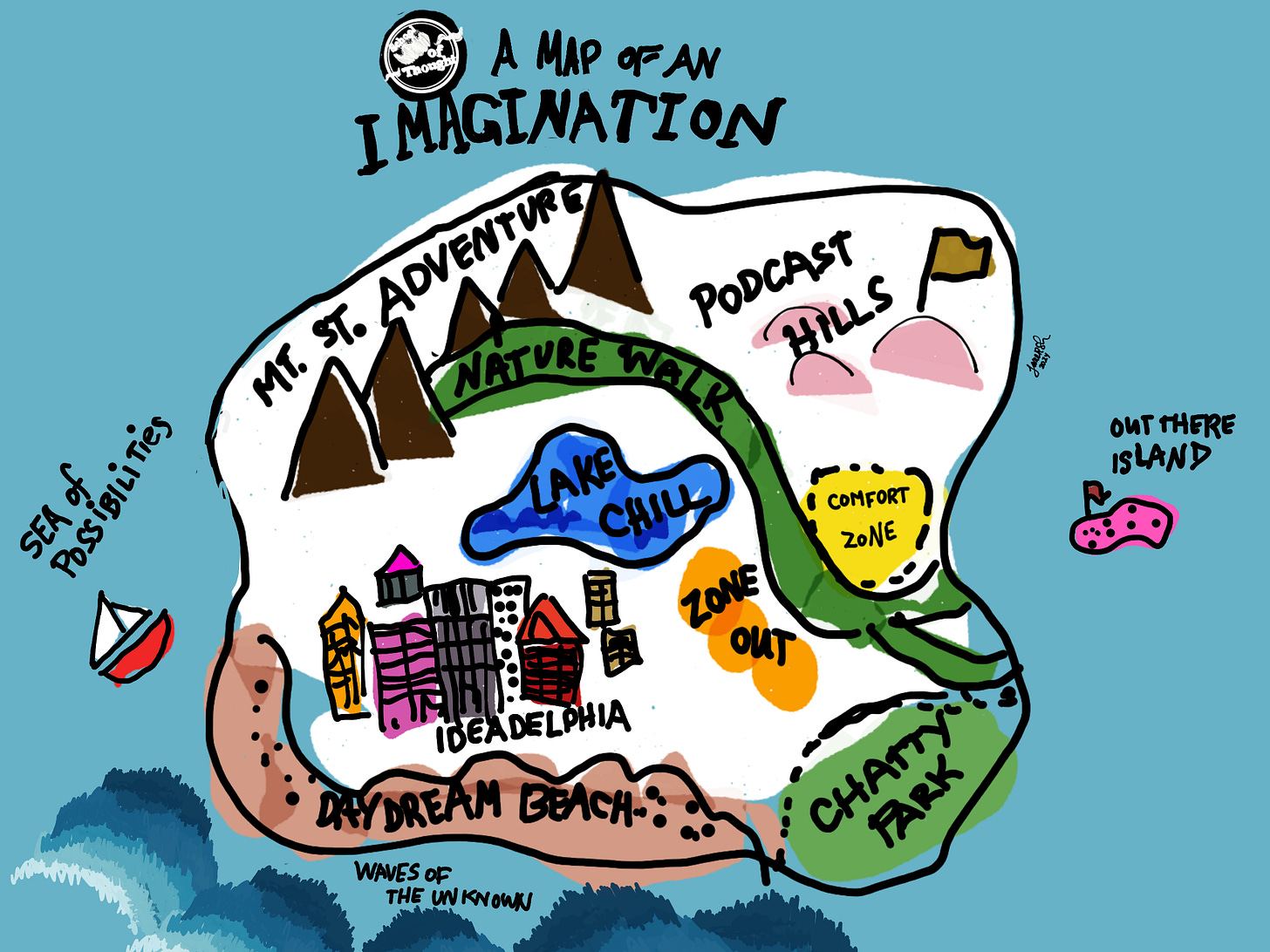Imagination Mapping to Build New Castles
Five questions to ask to free your mind for creativity.
If you click the ♥️ it will help more people find School of Thought. Appreciate YOU.
“In order for us to truly create and contribute to the world, we have to be able to connect countless dots, to cross-pollinate ideas from a wealth of disciplines, to combine and recombine these pieces and build new castles.” Maria Popova
When I was little, my Grandmom Anne used to give me blank journals for drawing and poetry and stories. I called them my Idea Books. When I wanted to write or draw or tell a story, that’s where it all went.
Every time I finished one, I’d give it to her and she’d get me another.
She’d keep each finished book next to her bed at her house, where she said she could look through them all the time. We had sleepovers there once or twice every month. When I’d sleep over, I’d look through them and remember things I thought or made. An old idea would spark a new and more would come.
I was reminded of this process as I had a blank page challenge this month. I wanted some on demand creativity, a new idea, and it wasn’t happening.
But I’ve realized ideas are like anything good - happiness, love, the perfect dress for a party - if you are looking too hard, you won’t find them.
So what to do?
The Big Idea
Ideas hit at unexpected moments, so it’s hard to conjure them on demand.1
But as I started thinking recently about the Idea Books of my childhood, I realized these served to conjure a constant stream of creativity.
This brings me to first rabbit hole 🐇: the concept of combinational creativity. Combinational creativity is about combining old ideas to uncover new ones.
Celebrated creators – artists, writers, scientists, inventors – know its power.
“Creativity is just connecting things. When you ask creative people how they did something, they feel a little guilty because they didn’t really do it, they just saw something. It seemed obvious to them after a while." Steve Jobs
“I steal from every single movie ever made. I love it—if my work has anything it’s that I’m taking this from this and that from that and mixing them together….I steal from everything. Great artists steal, they don’t do homages.” Quentin Tarantino
“Science,” Darwin recognized, “consists in grouping facts so that general laws or conclusions may be drawn from them.”
“Substantially all ideas are second-hand,” Mark Twain observed, “consciously and unconsciously drawn from a million outside sources, and daily use by the garnerer with a pride and satisfaction born of the superstition that he originated them.”
Smartphones, podcasts, ice cream sandwiches, skateboards - all combinations. But also collage, and novels, and science and music.
But to get there we need (second rabbit hole alert🐇): Creative Inbox systems.
I appreciate the advice of David Allen, author of Getting Things Done, “Your brain is for having ideas, not storing them.”2
I had never connected this to those blank books my grandmother used to get for me, but realized the practice might be what led me to blogging. Those books, with their blank pages to create, and loop ideas together, were really my first creative inboxes.
A system gives us the mental energy to focus on bringing the best ideas to fruition while also noting down other ideas for future reference without weighing us down cognitively.
To put creative ideas to use, we need maps. This brings me to a question:
Where do you map your imagination?
(And where do we support youth in developing their practices?)
I love this analogy from a cartographer, Peter Turchi.
“The earliest maps are thought to have been created to help people find their way and to reduce their fear of the unknown. (…) Now as then, we record great conflicts and meaningful discoveries. We organize information on maps in order to see our knowledge in a new way. As a result, maps suggest explanations; and while explanations reassure us, they also inspire us to ask more questions, consider other possibilities.” Peter Turchi, in Maps of the Imagination.
Maps reduce the fear of the unknown. They allow us to chart new territory. Whatever our maps might be, we need them to navigate our way to new ideas3
I feel grateful that I had a creative outlet when I was younger. I wonder how we can support young people today with building their maps.
A solution: In order to tap into creativity, we need to maintain creative inboxes and regularly both weed out and map connections to bring ideas to life.
Said another way:
Combinational Creativity + Creative Inboxes = More Ideas Brought to Life
Making Big Ideas Usable
I spent time looking for inspiration last month, when really what I could have done is combine ideas I already had in storage and map them in new ways.
The why:
Our minds rarely store ideas without systems, so we need to build them.
Systems for ideas organize the mind and allow it to be more creative.
Creativity is less about novelty of source, and more a source of novelty.
So I am sharing my own creative inbox and mapping systems for writing, and the mapping systems of some inspiring others.
✨This is NOT a step by step on how to be creative or an instructional guide.
This post is documentation of the evolution of my thinking and process. Would love to know your strategies.




